Executive Summary
Many retailers are struggling to devise the perfect cross-channel experience for their customers—one that takes advantage of digitalization to provide targeted, just-in-time product or service information in an effective and seamless way. The key internal capabilities needed to ensure a successful digital shopping experience are personalization, automation and the unique identification of the customer across shopping channels.
In this report, we discuss how AI and IoT are impacting the retail industry. We explore how these technologies are changing the way retailers operate and provide examples of how major industry players are using AI and IoT to increase operational efficiency and unlock new revenue opportunities. Retailers that aim to remain competitive cannot afford to ignore the potential benefits of these technologies.
AI in Retail: Offering Data-Driven Personalization and Customer Service
AI, a technology that enables computers to make autonomous decisions, is a step forward in automation that is changing the retail industry. Retailers are using AI to analyze customer data, adapt how they interact with shoppers and predict demand in order to better manage inventory.
Because consumers are bombarded with an unprecedented amount of information, being able to deliver highly personalized content for each individual customer is crucial to staying ahead of the competition. Meanwhile, the use of AI to anticipate demand and estimate when items will be returned should translate into more efficient business operations.
Retailers are making significant investments in AI technology, and the retail industry is the third-largest end market for its application, according to market intelligence firm Tractica.
IoT in Retail: Digitalizing Brick-and-Mortar Stores
Digitalization is the key that will unlock the future of brick-and-mortar retail, and the IoT is a crucial part of it. We define IoT as including any Internet-connected device that is capable of sending information to a cloud storage system and/or interacting with other Internet-connected devices.
IoT applications in brick-and-mortar store environments bring many advantages to retailers. They can make operations more efficient thanks to the connected devices’ ability to track inventory levels in real time and also help retailers improve the customer store journey by increasing engagement through devices such as interactive smart mirrors.
Companies such as Amazon and Walmart are already applying IoT technology in their physical stores. Amazon is testing a new grocery store format that uses AI to provide a checkout-free shopping experience, while Walmart plans to introduce a smart shopping cart that helps shoppers navigate through the store and find products on the shelves.
Introduction to AI
AI is a step forward in automation that is already changing the retail industry. AI enables retailers to drive sales and anticipate demand, to gain a better understanding of consumer behavior and to offer highly accurate individualized promotions.
For example, AI can decide for the retailer what items to show to shoppers and how to display and present them, and it can recreate the interaction that the shopper experiences with store associates at brick-and-mortar stores by guiding and advising the customer.
Retailers that aim to remain competitive cannot ignore the benefits of the application of AI technology to their operations—in particular, the ability to provide a personalized and straightforward shopping experience and to scale up the use of customer data.
AI in Retail Operations
AI automates decisions through algorithms informed by machine learning, a technology that enables computers to observe and learn from large sets of data and make decisions without the need for human input.
Retailers use AI to analyze customer data in order to gain a better understanding of consumer behavior, to adapt the approach through which the company interacts with shoppers and to predict consumer demand.

Source: FGRT
AI is a step forward from previous applications of computing to retail operations, which offered more basic automation. Through AI, computers can observe data, strategize and then implement a strategy.
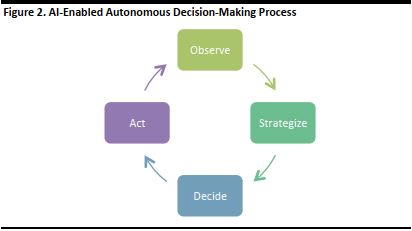
Source: Sentient/FGRT
We identify three main applications of AI in retail:
- Personalization: AI enables retailers to provide a personalized approach to each customer through a customization of shopping recommendations, e-commerce and m-commerce portals layout and promotions.
- Customer service: AI is used to operate chatbots that mimic the client’s interaction with a sales associate or a customer-care assistant. The technology is able to detect the tone of the user’s messages and understand what is the best way of responding to the client’s need.
- Inventory management: Retailers can predict what customers are likely to buy in the near future, thanks to data analytics powered by AI. This enables retailers to maximize the probability of having the right items in stock as the customers order them, which results in faster fulfillments and leaner inventory operations.
AI is already widely used in retail, but the technology tends to have a low profile. In a survey of UK retailers published in 2017 by specialist publication
Retail Week and retail tech firm Qubit, some 38% of respondents were already applying AI to their business operations, and 48% were already using machine learning.
Half of the retailers questioned for the
Retail Week/Qubit survey use the analytic and predictive ability of AI to drive sales and anticipate demand, while 46% use the technology to gain a better understanding of consumer behavior and to offer highly accurate individualized promotions, as shown below.
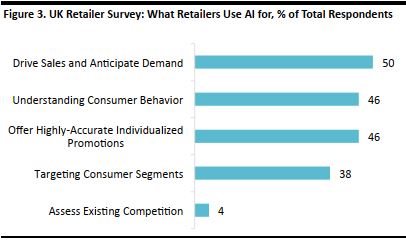
Survey published in 2017.
Source: Retail Week/Qubit
Retailers and Tech Firms Collaborate to Apply AI
Amazon, Shop Direct and Otto Group are among the retailers using AI. In this section, we profile selected examples of how retailers are collaborating with tech companies to implement AI solutions for the three aforementioned applications in personalization, customer service and inventory management.
Intelligent Personal Assistance: Amazon Echo and Alexa
Amazon Echo is one of the best-known applications of AI by a retailer. Amazon Echo is a small device with an embedded microphone that connects the user to Amazon’s AI-powered intelligent personal assistant Alexa. The device enables the user to receive information and services by voice command. For example, Alexa can answer questions, provide information, play music, control Internet-connected home systems such as lighting, order take-away and request a taxi ride.
Amazon Echo is also another channel through which the user can buy products on Amazon’s marketplace. Users of the Amazon Echo device can ask Alexa to shop for products, but only those users with Prime memberships can buy directly through the virtual assistant via voice commands. Customers who are not Prime members are limited to adding items to their online baskets through Alexa. For nonspecific product requests such as “buy dog food,” Alexa analyzes the user’s order history to find relevant products before fulfilling the command.
Voice shopping is likely to work particularly well for replenishment purchases of lower-value, everyday items. Consumers typically buy food products, toiletries and household-care goods by brand, so do not need to see the product before they check out. Alexa should, therefore, help Amazon build share in groceries.

Source: Amazon.co.uk
Alexa was built on the technology developed by Evi, a British startup acquired by Amazon in 2012 that developed the software capable of accurately interpreting questions and framing more natural, conversational answers, the features that stands behind Alexa.
Retail Personalization: Sentient Technologies and Cosabella, Mad Street Den and Vue.ai
Cosabella: Lingerie firm Cosabella collaborated with tech company Sentient Technologies to deploy AI on its website. Cosabella uses an AI- powered algorithm to test alternative options for its website design based on the conversion rate generated by each variant. Traditionally, this process would have been carried out with A/B testing, which is quite time consuming. The optimization of website design through AI resulted in a 30% increase in conversion rate, according to Cosabella.
Sentient Technologies: Sentient uses AI to help retailers increase m- commerce conversion rates. The tech firm developed a mobile-friendly interface that encourages shoppers to interact by highlighting which products they like and do not like. The service learns from this information and uses it to recommend only the products that match each customer’s style, in the same way a store associate could do in a brick-and-mortar store. This creates a more engaging and simpler way of shopping with a smartphone, and the company says it results in about 150 possible layout variations and a 38% increase in conversion rates.
The application of AI is particularly useful in m-commerce, where screen space is limited and it is very important to highlight the most relevant products for the customer. Currently, smartphones see a lower conversion rate compared to desktops—just 1.55% versus 4.14% in the fourth quarter of 2016, according to analysis by tech firm Monetate.
Vue.ai: Another AI-powered service is offered by Vue.ai, a sub brand of Indian tech startup Mad Street Den. The AI technology behind Vue.ai enables retailers to personalize the website based on individual shoppers’ preferences. The technology learns from shoppers’ browsing and shopping histories and displays items that match their preferences and provides personalized shopping recommendations. The service generates an increase of 144% in product viewing and a 110% increase in average order value, according to the company.
Customer Assistance: Shop Direct and IBM
British pure-play online retailer Shop Direct is working with IBM to develop an AI-powered chatbot that can detect a customer’s mood. The service—which is set to be launched later this year—uses IBM’s AI software Watson to detect users’ moods based on the words they use and the tone of their messages.

Diagram Showing IBM Watson AI-Powered Conversation Service.
Source: Ibm.com
[caption id="attachment_88588" align="alignright" width="90"]
 Very.co.uk Chatbot Featuring CUI Technology. Source: Essentialretail.com
Very.co.uk Chatbot Featuring CUI Technology. Source: Essentialretail.com[/caption]
By understanding customers’ moods, the technology can direct them to the relevant employee for help through human interaction via chat or more traditional channels such as a telephone customer service line. Shop Direct aims to use the AI-based chatbot to free its workforce from repetitive tasks and to focus more on the interactions that really help customers. The company already uses conversational user interface (CUI) technology for its Very.co.uk chatbot to assist with customer queries, but the introduction of an AI- powered chatbot should raise the quality of the interactions. Shop Direct also uses machine learning to personalize consumer touchpoints, including homepage content and promotional emails.
Replenishment Optimization: Otto Group and Blue Yonder
German online and catalog retailer Otto Group shows how AI can be used for inventory management. Working with Blue Yonder—a market leading provider of AI solutions for retailers—the German firm uses AI to predict what customers will buy in the near future.
The technology was developed by Blue Yonder—which is partly owned by Otto Group—and was initially designed for particle physics experiments at the European Organization for Nuclear Research (CERN) in Geneva, Switzerland. It can analyze around three billion historical transactions and 200 other variables (such as weather conditions and website searches) to predict future purchases. This enables Otto Group to automatically process orders with partner suppliers for about 200,000 items a month.
The system helps Otto to stock what its customers are likely to buy, enabling the retailer to achieve faster deliveries and reduce returns. The solution can reportedly predict with 90% accuracy what will be sold within a 30-day period, and allows Otto to reduce dramatically its delivery schedule for partner products—from seven days to one or two days— often enabling direct delivery from the supplier to the customer without passing through Otto’s warehouse.
Through Blue Yonder’s replenishment optimization solution, Otto also succeeded in reducing returns by two million items a year—because the sooner shoppers receive the items, the less time consumers have to shop around for better prices and return the products—and in cutting stock surplus by one-fifth, according to
The Economist.
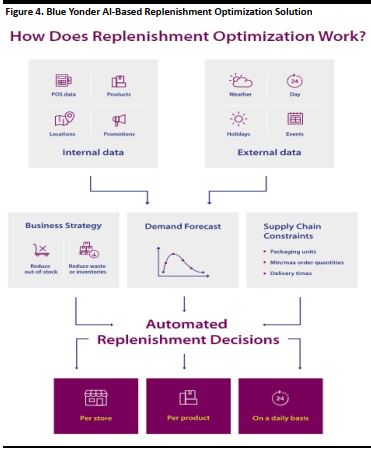
Source: Blue-yonder.com
Otto Group also uses AI technology to offer a product evaluation feature that enables shoppers to select keywords that are most relevant to them from previous customers’ products reviews. Reviews are aggregated according to the keywords that best define their focus—for example, reviews about a washing machine can be grouped with themes such as “washing result.” The AI-based technology applies an algorithm that analyses over one million product reviews every day and groups them according to the main topic and whether they are positive, negative or neutral, so consumers can easily identify the most helpful reviews to inform their purchasing decision.

Otto’s AI-Based Product Evaluation Feature.
Source: Otto.de
Retailers Should Embrace AI to Stay Competitive
AI looks to be the best way retailers can capitalize on the abundance of customer data that are made available by the digitalization of the industry. In the aforementioned
Retail Week/Qubit survey, 82% of respondents think that machine learning will have an impact on the retail industry.
Three reasons why retailers should invest in AI are:
- The ability to provide a personalized and straightforward shopping experience: AI is an effective way for retailers to deliver a tailored shopping experience, with proven benefits in conversion rates.
- The ability to scale up use of customer data: The digitalization of retail gives retailers access to an unprecedented level of consumer data. AI gives retailers the tools to manage more effectively this data and to use it to improve operations and profitability.
- Competitors are investing in AI: AI is attracting significant investments, and the retail industry is one of the top end-markets for the technology. With 12% of the global AI-generated revenue in 2015, retail is the third-largest end-market for the technology, according to market intelligence firm Tractica.
At a time of significant innovations in retail and in other industries, AI is one of the technologies that has raised the most interest.
A 2017 survey of 500 top North American retailers by research firm BRP found that 14% have already adopted AI-powered chatbots and digital assistants, while a further 32% plan to introduce the technology in the next three years.
Since 2012, deals and dollars invested in AI startups have been on the rise, and 2016 was a record year for startups globally. According to research firm CB Insights, AI-focused companies raised over $5 billion in funding in 2016. Deals reached a 5-year high last year, from 160 deals in 2012 to 658 in 2016.
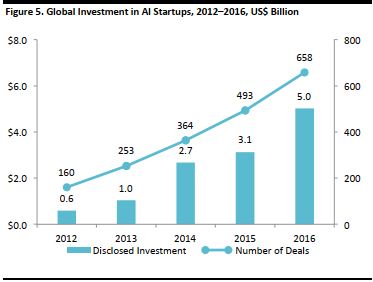
Excludes robotics (hardware-focused) and AR/VR startups.
Source: CB Insights
Revenues generated from AI worldwide are forecast to grow by a CAGR of 53% in the period from 2017 through 2025, according to Tractica.
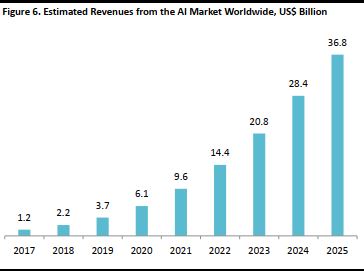
Source: Tractica
AI Key Takeaways
AI is used in retail to analyze customer data, adapt the approach through which the company interacts with shoppers and predict consumer demand to enable better inventory management.
AI enables retailers to drive sales and anticipate demand, to gain a better understanding of consumer behavior and to offer highly accurate individualized promotions.
AI will likely have a significant impact on the future of the retail industry, and retailers that aim to remain competitive cannot ignore the potential benefits of AI.
Introduction to IoT
IoT technology has the potential to transform the way retailers operate their brick-and-mortar operations. Our definition of IoT is any device that is Internet connected, capable of sending information to a cloud storage system and/or can interact with other Internet-connected devices.
IoT applications in retail consist of connected devices mainly used to track inventory and consumer behavior or to improve the consumer’s shopping experience by making it more engaging. This section focuses only on in- store IoT usage, and does not consider the retail supply chain or logistics.
Applying IoT technology to a physical store environment can increase the efficiency of operations and unlock new revenue opportunities, among other advantages.
IoT in Retail: Tracking Store Performance and Interacting with Customers
We can distinguish between two core types of IoT retail technology, according to the main function of the connected devices:
- Technology that tracks inventory and/or consumer behavior: This includes devices with radio-frequency identification (RFID) sensors that can track the location and movement of items in-store, as well as track consumer behavior in-store.
- Technology that interacts with customers: This includes devices that make shoppers’ experience easier and more engaging, such as smart mirrors that enable customers to virtually try on clothing.
The application of IoT devices in stores is part of the broader trend that is seeing the adoption of technology in brick-and-mortar operations. In Figure 7, we list selected technologies that are finding applications in brick-and-mortar stores. Some of those listed are borderline IoT or may not be considered IoT within our definition, but they are adjacent to and, in some cases, interchangeable with IoT products. Beacons, for example, operate a relatively simple system of localized Bluetooth transmissions; the “work” is done by the user’s smartphone in response to those transmissions.


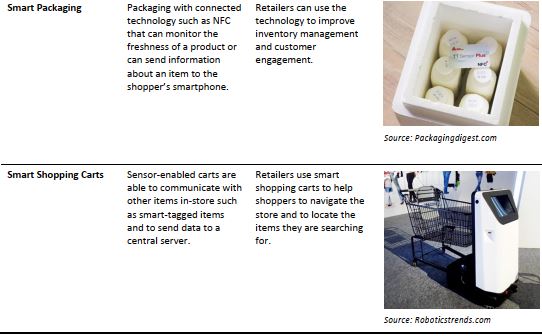
Source: FGRT
Advantages of IoT in Retail
Essentially, the application of IoT technology helps retailers make inventory management more efficient, measure store performance and improve the customer experience. In particular, IoT in retail can bring the following advantages:
- Optimization of store operations: A major advantage of IoT in retail is the digitization of in-store inventory. This makes it possible for retailers to track inventory levels and location of items in-store at any time in order to avoid misplaced stock. This improves store readiness, increases transparency and visibility of the operations and makes it possible to run systems that improve efficiency, such as automated alerts for stock replenishment.
- In-store analytics: Data generated by tracking the movement of items in-store and consumer behavior makes it possible to record metrics such as conversion rates and to make decisions to improve store performance such as increasing the visibility of the best- performing items. For example, using sensors to track the movement of items in-store—such as which items are tried on and brought to the checkout for purchasing—can help managers improve store layout by placing more popular products in high- traffic areas.
- Closer integration with the rest of the supply chain: In-store inventory tracking through IoT enables closer integration with other stages of the supply chain such as distribution, supporting more efficient operations. We provide an overview of the benefit of an integrated apparel supply chain through digitalization in our report, An Overview of the Digitalization of the Apparel Supply Chain.
- Improved consumer experience: In-store connected technology increases merchandise engagement—for example by using smart mirrors that enable customers to virtually try on items or through NFC tags that send information about an item to the customer’s smartphone.
- New revenue opportunities: By increasing the opportunities for customers to connect and interact with retailers, IoT can help retailers grow revenues. For example, using in-store digital screens, shoppers could order sizes or colors that are not in stock in-store.
In Figure 8, we illustrate a tangible example of how IoT technology improves retail operations—comparing the level of inventory accuracy between barcoded and RFID systems.
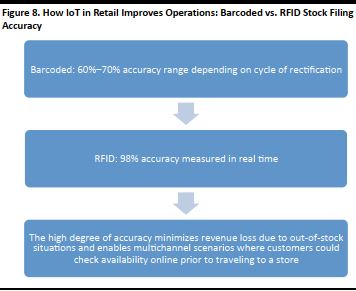
Source: Smartrac-group.com
By increasing the efficiency of retailers’ operations, IoT generates value growth for the retail industry as a whole. The adoption of IoT technologies is expected to bring to the retail industry an estimated total economic benefit of £4.5 billion (US$5.6 billion) in the period from 2015 through 2020, according to the business analytics software organization SAS Institute. However, unlike the brick-and-mortar-store focus of this report, that total is likely to incorporate benefits yielded in the retail supply chain and logistics.
Technologies that Can Change Store Retailing
IoT in retail has the potential to transform the way brick-and-mortar stores operate, how they are managed and how they interact with customers. Signs of the profound impact that digital technologies have on brick-and- mortar operations are already visible. In particular, the new concept store Amazon Go shows how to provide a frictionless grocery shopping experience with the use of AI.
Another noteworthy application of IoT in retail is VLC, which promises to revolutionize the way the retailer engages with the shopper in-store. Other examples of how IoT changes the way customers shop in brick-and- mortar stores include Rebecca Minkoff’s connected store, Razorshop by Razorfish ShopWithMe by With.Me, and Walmart’s and Panasonic’s Smart Shopping Cart solutions. In this section, we provide short profiles for each of these innovative concepts.
Amazon Go: The Store Run by AI
On December 5, 2016, Amazon announced the launch of Amazon Go, a new concept store without checkout lines. Amazon Go use AI to provide a frictionless shopping experience. The idea is to eliminate waiting time and lines at the checkouts by eliminating physical checkouts.
Using an Amazon Go app, shoppers swipe their smartphones on turnstiles as they enter the store. A system of computer vision, sensor fusion and deep learning detects which products the shopper picks up and which ones are returned to the shelves and charges the customer accordingly. The total balance is then charged on the shopper’s Amazon account. The customer can just walk out, as payment will be taken automatically from the bank card filed with the account. Amazon points out that similar technology is being used in self-driving cars.
Engage with Shoppers Through Light with VLC
VLC is a technology that uses light sources such as LED light bulbs to send information through visible light that can be received and read by devices, including smartphones, through their camera. The system can act as an indoor positioning system. In brick-and-mortar retailing, VLC can be used to send location-based notifications to shoppers’ smartphones—for example information about promotions or directions to help customers navigate through the store and locate the items they are looking for.
In 2015, French retailer Carrefour introduced VLC in its hypermarket EuraLille in Lille, France. The technology, from Dutch electronics firm Philips, was tested by the retailer as part of a promotional campaign “Promo C-où” to help consumers locate promotional offers in-store. Through an app, shoppers could compile a shopping list of items on offer. Once in-store, VLC would send directions to the customers’ smartphone to locate the items. The test lasted until the end of 2016, when the promotion ended.
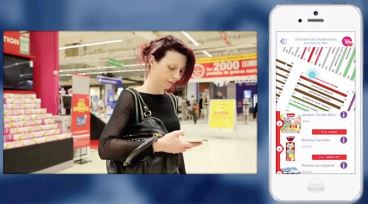
Source: Philips
Rebecca Minkoff Connected Store
Fashion firm Rebecca Minkoff operates a Connected Store in New York that features connected walls—a system of screens through which the shopper can browse the collection and order items to be sent to the fitting room by a store associate. The fitting rooms feature digital mirrors— mirrored displays that use RFID to recognize the items in the room and that suggest what other sizes or color are available in stock. Through the mirrors, the shopper can ask for other items to be brought to the fitting room, and request store personnel to send the selected items to the checkout for purchase. The digital mirror gathers data about the customers which will enable the device to give the shopper style recommendations based on their past shopping history.

Source: Digiday.com
Razorshop by Razorfish
US tech companies Razorfish and Adobe have developed Razorshop, a digital retail environment that enables the profiling of customers in order to positively influence their shopping behavior and provide them with a personalized shopping experience. The service combines a series of proprietary technology:
Bluetooth Low Energy Experience Platform (BLEEP): BLEEP recognizes a shopper’s smartphone and sends information about items in stock as the customer enters the store.
In-store Customer Engagement Application (ICE): ICE runs on tablets through which the store associate can browse information—stored in a secured cloud—about a customer’s shopping behavior, preferences and history.
Adobe Software: This is used by the solution to provide store managers with analytics to improve store performance and the customers’ shopping experience.
The smart shop also features other devices, including interactive displays through which the store associate can show the outfit options to customers based on their preferences.
ShopWithMe by With.Me
ShopWithMe is an interactive store in Chicago developed by retail tech company With.Me. The outlet houses collections from TOMS Shoes and Raven + Lily, and features a 30-foot-long pixel wall with interactive shelves that can move toward customers as they browse. The system suggests items to shoppers according to their individual preferences, based on data gathered by the in-store technology which monitors the browsing behavior of the shoppers. Dotted throughout the store are interactive tables—tables with an interactive screen that gives information about items, which are RFID tagged, as the shopper places them in the proximity of the surface.

Source: Electric Runway
Walmart and Panasonic Smart Shopping Cart Solutions
Walmart: US retailer Walmart is collaborating with tech company Five Elements Robotics on the development of a smart shopping cart that will help shoppers navigate through a store to find products on the shelves. The cart operates through a network of sensors that send data to a central computer that tracks inventory and matches the customer’s shopping list with the available inventory. The central computer will then send directions to the smart carts about the location of the items on the list within the store. The patent was filed in March 2016, but the technology is still not operational in Walmart stores at the time of writing.
Panasonic: Japanese electronics firm Panasonic has developed a similar solution, a smart shopping basket designed to detect items in a cart and calculate the bill. At the checkout, the bottom of the basket opens up and the items slide into a shopping bag. The company tested the solution in a Lawson store in Osaka and announced that the system will be fully operational by February 2017, according to
The Wall Street Journal.

Source: ANN News
Further Examples of IoT Applications in Retail: Catalyst and Smartrac
In this section, we provide an overview of IoT products by two companies: Catalyst (a Li & Fung company) and Dutch tech company Smartrac. The two companies are working together on a RFID partnership to offer in- store product tracking.
Catalyst: Inventory Control for Retail
Catalyst provides innovative RFID products to help retailers managing retail inventories. Two of these products are Catalyst Scan and RFID Inventory Robot:
- Catalyst Scan: Catalyst Scan is an inventory management product, consisting of an RFID handheld reader that uploads data directly to the cloud. The scanner pairs with a smartphone through which the user can open an app, create an inventory or continue an existing inventory and populate it by scanning the items.
- Catalyst Robot: The Catalyst Robot is an RFID inventory management product that consists of an autonomous and mobile robot capable of completing store inventories. The robot easily navigates around retail spaces and provides stock availability and location data on a regular besis.
Catalyst also provides RFID products that enhance customer engagement in-store and improve the shopping experience:
- Catalyst Smart Screen: An interactive touch screen that allows users to interact with their garment on the screen, view the ‘complete look’ and view the garment’s product information. To activate the screen, the customer only needs to hold the garment close to the screen, which detects the RFID tag attached to the garment and pulls associated content down from the cloud.
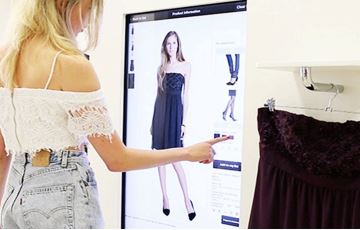
Source: Catalyst-direct.com
Retailers such as Burberry and Rebecca Minkoff (as discussed earlier in the report) already use similar technology in their stores. Burberry’s Regent Street flagship store in London features digital mirrors that use RFID technology to identify the garment the shopper picks up and shows on the screen further information such as outfit ideas.
- Catalyst Smart Tray: A tray combined with an interactive touch screen. When a customer places a product that has an RFID tag on the Smart Tray, the latter displays a range of information, including product features and benefits. The technology is typically used for cosmetics or footwear.

Source: Catalyst-direct.com
Smartrac Retail Store Optimization: Metrics
Dutch tech company Smartrac offers Metrics, a retail store optimization system that uses sensors to track store data. Smartrac’s system can also show store managers what happens when an item is taken to the fitting room and how well employees are engaging with customers. The system provides brick-and-mortar retailers with a wealth of inventory information to improve stock keeping, displays and sales conversion.
Metrics consists of a network of sensors that collect store data. Information is gathered through motion sensors, RFID devices and Point of Sales (POS) data feedback. All the information gathered is then stored in the cloud.
The system provides the same level of analytics available in an e- commerce environment, including:
- Insight to help executives improve store management.
- Actions for employees, such as alerts that tell when an item is out of place or when replenishment is needed.
Store managers can use the information to track KPIs, including:
- How long it takes to replenish the sales floor.
- How long it takes to stock an item that is received.
- How “clean” the store is (how many items are misplaced).
IoT systems such as Smartrac’s Metrics also enable executives to measure conversion from browsing or from trying on in fitting rooms. And managers can analyze how well employees engage with consumers in order to increase conversion.
Currently, retailers know what sells based on sales data. However, in-store IoT systems can give further information, such as identifying items with a low conversion ratio (items picked up many times, yet are not purchased often), or conversely, which items do not have enough visibility relative to their potential based on their conversion ratio. This information can help to improve the layout of the store by increasing the visibility of merchandise with potential for more sales.
Recommendations: Act Fast, Handle Data with Care, Review Relationship with Suppliers
IoT in retail offers many opportunities for retailers to improve efficiency, increase consumers’ engagement and ultimately generate more revenue from in-store sales. When implementing their strategies to adopt IoT technology in-store, we believe that retailers should consider the following: 1) act fast, as competitors are adopting new technologies; 2) set up clear policies on the handling of consumer data; and 3) redefine the relationship with other supply-chain stakeholders.
Act Fast, as Competitors are Adopting New Technologies
Retailers that wish to remain competitive should act fast and deploy an adoption strategy for IoT technology in-store.
IoT in retail is still in its early stage, but retailers are adopting technologies quickly. Only 4% of US-based apparel retailers had achieved full adoption of RFID tags as of June 2016, according to the Auburn University RFID Lab. However, the remaining 96% of retailers were working toward the achievement of full RFID adoption, as shown in Figure 3. Consequently, in the near future, we expect that most apparel retailers in the US will have RFID technology in-store.
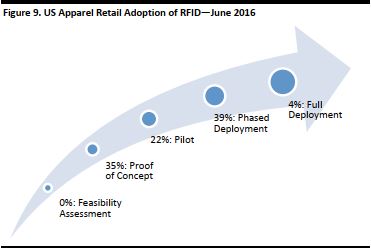
Source: Auburn University RFID Lab
Retailers are acting fast in adopting the technology: for instance, in the UK, retailers had a 21% IoT technology adoption rate in 2015, according to the SAS Institute. Considering the economic benefits in terms of increased efficiency that IoT brings to retail operations, it comes as no surprise that most players in the industry are undertaking strategies to adopt the technology.
Set Up Clear Policies on the Handling of Consumer Data
Retailers that adopt in-store IoT technology need to consider the legal implications of tracking consumers’ data, make it clear to consumers when data is recorded and for what reasons, and define clear data handling responsibilities and compliance procedures within the organization.
The collection of consumers’ data that IoT in retail makes possible could raise concerns among shoppers. According to a survey undertaken by research organization ComRes, 69% of respondents voiced concerns about the collection and use of personal data by organizations through connected devices.
Moreover, data protection regulations could undermine retailers’ ability to use data gathered by IoT technology for consumer behavior analytics. For example, the General Data Protection Regulation (GDPR), a new regulation that will regulate data protection in the EU and comes into effect from 2018, introduces more stringent provisions for organizations—including retailers—operating in the EU and using data processing technology.
Redefine the Relationship with Other Supply-Chain Stakeholders Retailers adopting IoT technology should redefine the relationship with other stakeholders within the supply chain, and choose business partners with operations that are ready to effectively meet the requirements of the increased efficiency the technology brings to the retailer.
We have seen in the report how the IoT technologies that track in-store inventory can bring a closer integration and better coordination with the rest of the supply chain, making the retailers’ operations more efficient. For example, in-store sensors can be used to track inventory in real time and to process orders more swiftly. Figure 10 summarizes the closer integration between the retailer and the supplier enabled by IoT technology.
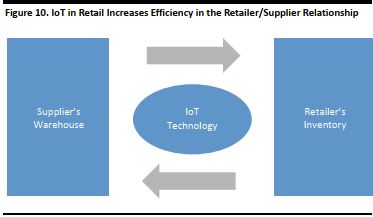 Source: FGRT
Source: FGRT
In order to capitalize on these advantages, retailers should partner up with suppliers that can receive and respond promptly and efficiently to the frequent orders triggered by the retailer’s real-time inventory tracking system.
IoT Key Takeaways
IoT technology has the potential to transform the way retailers operate brick-and-mortar stores. RFID, NFC and VLC are among the technologies offering promise to retailers.
IoT brings many advantages to retailers, such as making store operations more efficient due to the connected devices’ ability to track inventory levels in real time, or the possibility of improving the customer’s store journey by increasing the merchandise engagement through devices such as smart mirrors.
Companies such as Amazon, Walmart and Carrefour are applying IoT technology in their brick-and-mortar operations. We can expect other retailers to follow suit, in a bid to catch up with the industry leaders.
Retailers looking to adopt IoT technology in-store need to consider the implications of handling shoppers’ data gathered through IoT technology in order to avoid data protection breaches. Moreover, retailers should also endeavour to work with suppliers ready to help them capitalize on the increased efficiency brought by IoT.
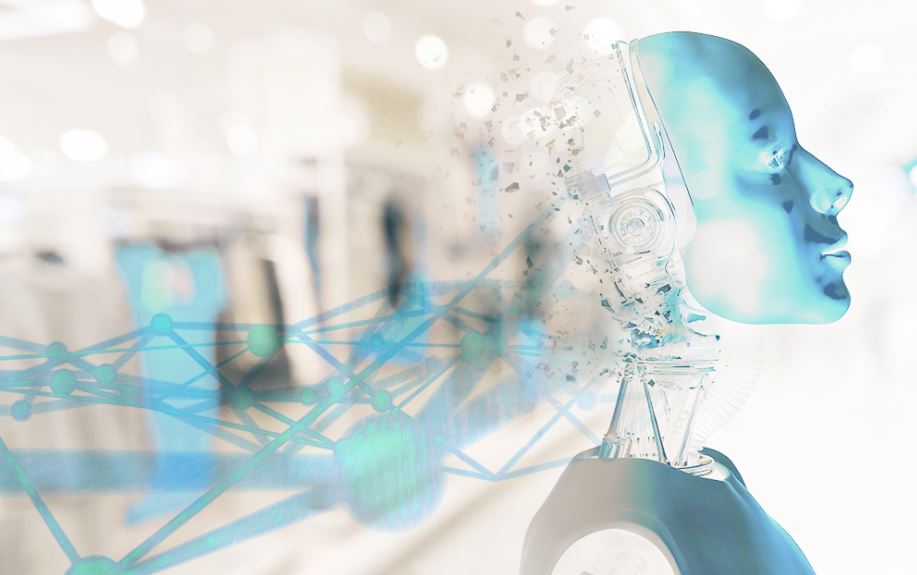





 Very.co.uk Chatbot Featuring CUI Technology. Source: Essentialretail.com[/caption]
By understanding customers’ moods, the technology can direct them to the relevant employee for help through human interaction via chat or more traditional channels such as a telephone customer service line. Shop Direct aims to use the AI-based chatbot to free its workforce from repetitive tasks and to focus more on the interactions that really help customers. The company already uses conversational user interface (CUI) technology for its Very.co.uk chatbot to assist with customer queries, but the introduction of an AI- powered chatbot should raise the quality of the interactions. Shop Direct also uses machine learning to personalize consumer touchpoints, including homepage content and promotional emails.
Very.co.uk Chatbot Featuring CUI Technology. Source: Essentialretail.com[/caption]
By understanding customers’ moods, the technology can direct them to the relevant employee for help through human interaction via chat or more traditional channels such as a telephone customer service line. Shop Direct aims to use the AI-based chatbot to free its workforce from repetitive tasks and to focus more on the interactions that really help customers. The company already uses conversational user interface (CUI) technology for its Very.co.uk chatbot to assist with customer queries, but the introduction of an AI- powered chatbot should raise the quality of the interactions. Shop Direct also uses machine learning to personalize consumer touchpoints, including homepage content and promotional emails.















 Source: FGRT
Source: FGRT